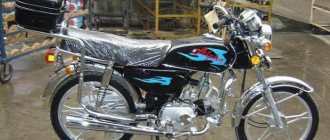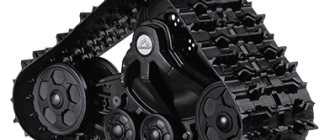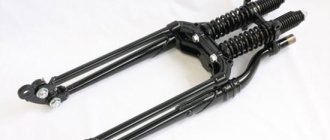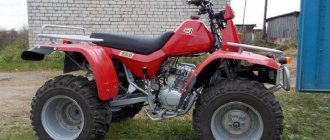- Transmission oil for ATVs CFMOTO
When using active equipment, do not forget about its maintenance, monitor the general condition of the ATV and change or top up technical fluids on time. The service life of the equipment depends on this.
Using only original components and motor oils for an ATV recommended by the equipment manufacturer, you can fully experience the “buzz” of owning such a machine, since it will not let you down, no matter what difficult situation you find yourself in.
ATV Engine Oil
Content
The popularity of ATVs has determined the width of their model range - from simple models with minimal equipment to powerful multi-axle options for purely utilitarian purposes.
A separate article is sports ATVs, which are distinguished not only by highly accelerated engines with an extremely lightweight design, but also by the use of manual transmissions instead of the usual CVT. This technique can be an excellent way to get adrenaline and help a hunter or farmer. A competent choice of oil for an ATV engine will allow you to achieve maximum service life from it. This is especially important during severe operation - transporting heavy loads, fording, etc. Even on a prepared ATV with snorkels installed, there is a high risk of water getting into the crankcase, which means that the protective properties of the oil must be at a high level. In any case, if an emulsion is detected on the dipstick or in the oil tank (on ATVs with a dry sump), the oil must be changed immediately. They will require inspection and a gearbox.
For most models of four-wheeled vehicles, ROLF Lubricants GmbH can offer decent quality and attractively priced oils with reliable protection against counterfeiting.
Features of operating an ATV in cold winter conditions
For operation in subzero temperatures, it is advisable to use oils with good low-temperature properties.
Such oils are made on HC or synthetic bases. Use with mineral water or semi-synthetic is possible, but it must be taken into account that in severe frost the pumping of these oils is very difficult, and the engine may suffer if there is insufficient lubrication. An ATV, like any equipment, must be prepared for winter use. Change technical fluids, if necessary, check and charge the battery. Treat rubber bands and wires with silicone to protect them from freezing.
What kind of oil to pour into an ATV engine
ATV engine oil must first match the type of engine. The vast majority of existing models are equipped with one- or two-cylinder water-cooled gasoline engines, that is, they require API S oils. A small number of ATVs produced in the simplest configuration continue to use 2T engines - they are simpler, cheaper and lighter. In this case, only special two-stroke oils of API TC quality class can be used.
Heavy utilitarian ATVs, including those of the Side-by-side class, are also equipped with diesel engines. For them, it is worth choosing a specialized oil for diesel engines (API class group C), but it is also possible to fill with universal motor oils, since their characteristics are suitable for diesel engines used on utilitarian ATVs.
The frequency of oil changes is determined by the manufacturer and is given in the service book. It is recommended to change the oil at the beginning of the season if the ATV is not used in winter, even if it has only had low mileage in the previous year.
Transmission
One of the most important components is the gearbox, which also requires compliance with the required oil level and its systematic replacement. The box can be mechanical, semi-automatic and automatic. The latter option has become most widespread on low-power and children's ATVs. A semi-automatic system can be found in vehicles that have the function of connecting all-wheel drive under established road conditions. A manual transmission is used on sports ATVs.
The viscosity of the oil used in the gearbox is selected individually, depending on the conditions and required characteristics. For example, automatic transmissions require ATV transmission oil, while manual transmissions can use any type of fluid. As for the choice of viscosity degree, this parameter is selected taking into account the type of gearbox and its thermal load.
Is it possible to put car oils into an ATV?
Since most ATVs are equipped with a CVT transmission and do not have a clutch in an oil bath, they do not have an urgent need to use 4T motor oils. The fundamental difference between motor oils for four-stroke engines and conventional automobile ones is precisely the presence of friction modifiers and the normalization of antifriction properties, which is necessary to ensure normal clutch operation.
Therefore, the use of ROLF automobile motor oils on such ATVs is more than justified. For example, the operating instructions for BRP Outlander ATVs directly indicate that the original engine oil can be replaced by any SAE 5W-40 automobile oil with a quality class of at least API SG. Given such low requirements, any ROLF 5W-40 oil will work perfectly in this technique.
You can do the same when buying a diesel ATV. For example, for Polaris Ranger Diesel, the instructions require the use of original Polaris Diesel Oil (SAE 15W-40) engine oil or diesel oils that match the viscosity.
There are only two cases where you can’t pour car oil into an ATV engine. First of all, we are talking about sports models equipped with a “wet” clutch and a manual gearbox in a common lubrication circuit with the engine. They need specialized synthetic oils for four-stroke engines designed specifically for such operating conditions.
ATVs with two-stroke engines also require their own type of lubrication. Of the entire range of two-stroke oils, the optimal ones are those that are designed for motorcycles, taking into account their inherent operating temperatures and loads.
The best oils and products for ATV operation
Among the variety of oil products for ATVs presented, it is quite difficult to make the right choice. When choosing, you should rely on trusted manufacturers. With Liqui Moly oils you can be absolutely confident in the quality of the products you purchase. All products are manufactured exclusively (!) at our own factory in Ulm in Germany.
Liqui Moly technical specialists especially recommend paying attention to specialized oils designed for the loaded operating conditions of ATV and UTV.
· HC-synthetic motor oil for 4-stroke motorcycles ATV 4T Motoroil Offroad 10W-40. A special product made for high-load engines with wet and dry clutches and for wet-type CVTs. The oil has increased resistance to oxidation, overheating, water and dust.
You can view the entire list of products for ATVs on the website liquimoly.ru
Engine oil for ATVs ROLF MOTO 2T
This oil is designed as a universal oil for motorcycles with medium and large cylinder displacements. It is compatible with all types of lubrication systems, can work in a gasoline-oil mixture, in separate lubrication of carburetor engines and on two-stroke engines with electronic fuel injection.
ROLF Moto 2T oil meets the stringent current requirements for two-stroke oils for protection against wear, smoke, and carbon formation. It preserves the functionality of the spark plug for a long time, preventing contamination of the electrodes with unburned oil residues. Thanks to anti-wear additives, the engine remains protected from scuffing on the piston and cylinder walls at high temperatures.
Specifications
| Density at 15 °C, kg/m3 | 876,8 |
| Kinematic viscosity at 100 °C, mm 2 /s | 10,76 |
| Kinematic viscosity at 40 °C, mm 2 /s | 81,36 |
| Viscosity index | 118 |
| Flash point in an open crucible, °C | 158 |
| Pour point, °C | -42 |
| Quality classes | JASO FD/ISO-L-EGD, JASO FB/API TC |
| Tolerances | Rotax 253, Piaggio Hexagon |
Standards and Specifications
For four-stroke engines of ATVs with CVT transmissions, the same standardization systems are relevant as for cars. That is, the main quality classification is the commonly used API standard, and due to the less stringent environmental requirements for ATVs, outdated classes like API SJ are still used.
The viscosity of oils is also marked according to the SAE standard used for automobile oils. Since ATVs are often used not only in summer, but also in the off-season, and sometimes in winter, the optimal choice for them is all-season oils, which is confirmed by the above excerpts from the requirements of the instructions.
For ATVs with a wet clutch, the engine oil must also meet the JASO MA2 quality class. It takes into account the specific requirements of such engines for the antifriction properties of oils. In the ROLF product line, ROLF GT 5W-40 SN/CF has this approval.
Two-stroke oils are standardized according to a separate group of API classes, of which API TC is currently relevant. But it is optimal to choose an oil produced taking into account additional JASO/ISO specifications with a group of at least C (that is, JASO FC, ISO-L-EGC). Compared to API TC oils, they protect the engine better, smoke less during combustion, and form less soot.
Brake fluid for ATV
Over time, brake fluid gradually takes water from the air and begins to boil at lower and lower temperatures, which does not have the best effect on your safety.
For CFMOTO ATVs, we recommend using the time-tested brake fluid G-Energy Expert DOT 4 (comment - G-Energy Expert is the name of the brand/manufacturer, and DOT-4 and DOT-3 are performance classes of brake fluid, differing mainly in boiling point. As a rule, fluids of different classes are interchangeable (except for silicone brake fluids - they cannot be mixed with others), that is, you can use DOT-4 instead of DOT-3, but in no case vice versa. CFMOTO recommends using a more modern DOT-4 grade brake fluid to improve safety and extend the service life of the brake system).
Transmission oils for gearboxes
Since on ATVs the gearbox either does not require lubrication at all (dry variator), or the manual transmission is lubricated directly with engine oil, only the gearboxes require their own lubrication.
The selection of oil for replacement should be based on the properties of the original lubricant and the instructions in the operating instructions. Thus, gearboxes with a mechanical differential lock (including an external solenoid) can most often operate on conventional ROLF gear oils of API GL-4 or GL-5 quality class. For example, for Arctic Cat ATVs on most models, the instructions recommend using oils with a viscosity of SAE 75W-90 and quality class API GL-5. ROLF TRANSMISSION PLUS 75W-90 GL-4/GL-5 meets these requirements. A number of BRP ATVs require the use of a thicker 75W140 GL-5 oil, and there are no analogues for it in the current ROLF line.
Gearboxes with viscous couplings or electromagnetic couplings deserve special attention. The use of conventional transmission oils in them can disrupt the normal operation of the gearbox and even lead to its repair due to clutch failure. In particular, this applies to Polaris front gearboxes, lubricated with special Polaris Demand Drive oil.
Source
Approximate cost of oils from different manufacturers
Products from the following manufacturers are found on the Russian market:
- Liqui Moly. NS synthetics for a four-stroke engine costs 750-800 rubles per 1 liter (5W50) or 2300-2500 per 4 liters.
- Yamalube. For two-stroke engines 1 liter - 1000 rubles. For four-stroke engines: synthetic 10W40 – 1300 rubles per 1 liter, mineral 10W40 – 600.
- Motul. Synthetics for four-stroke engines cost about 1200 per 1 liter (5W40) or 4600-4700 rubles per 4 liters. For two-stroke engines - 600-800 rubles per 1 liter. For transmission - about 1400-1500 rubles per 1 liter (75W90). Mineral for four-stroke - costs about 600-700 per 1 liter (10W40) or 2200-2400 per 4 liters.
- Castrol. Engine 5W30 costs about 2300 rubles per 4 liters or 650-750 per 1 liter. For transmission - 75W90 costs 900 rubles per 1 liter, 80W90 - 400-450.
- Repsol. For four-stroke engines, 10W40 synthetic costs about 1000 rubles per 1 liter.
- Total. Synthetics cost about 500-600 rubles per 1 liter of 5W30 or 1400 per 4 liters.
- Shell. Synthetics for four-stroke engines cost about 2000-2100 rubles per 4 liters (5W40) and 650-700 per 1 liter.
Motul has the largest selection of oils. But Motul products are about 20-40% more expensive than average due to the popularity of the brand. Since the oil has to be changed frequently, it is not necessary to buy one.
And for completeness, original oil filters cost about 350-600 rubles. But instead of them you can install cheaper analogues for 200-400 rubles.
What kind of oil to put in an ATV
To ensure long-term operation of vehicles, including all-terrain vehicles, care should be taken to regularly change fluids and consumables. In this case, great importance is attached to the question of what oil to pour into the ATV. Preference should be given to brands that manufacture products in accordance with modern technologies. Thanks to this, such materials have excellent lubricating properties and provide protection to all engine parts.
Figure 1. Lubricants for all-terrain vehicles
Instructions for changing the oil of the Yamaha Grizzly 700 ATV
- Place the ATV on a level, level surface.
- With the engine off, check the oil level.
- Turn the system cover counterclockwise and remove.
- Remove the oil dipstick and wipe it with a clean cloth.
- Place the dipstick in the oil filler neck, remove it again and assess the lubricant level. Normally, the mark should be between the maximum and minimum value indicators.
- If the fluid level is below the minimum, add gas of a suitable class, bringing the level to the optimal level.
- Screw the dipstick into the oil filler neck and screw on the cap.
You can find out more about the characteristics and equipment of the Grizzly 700 on the website of the official Yamaha dealer in Russia.
Types of motor oils
There are three main types of lubricant:
The first of them consists of a completely mineral base. It's easier to find and costs less. Synthetic has better viscosity and high-quality additives. Its main disadvantage is the high price. Mineral oils have been used for a long time. Made from crude oil and undergoing a refining process, they have an unstable molecular composition. Synthetic counterparts have more consistent molecular chains, which provide the basis for a better lubricant.
Another advantage of synthetic materials is that when they are created, their molecules can be packaged for specific applications in different types of engines.
Semi-synthetic motor oil is a mixture of regular and synthetic, of which it contains about 30 percent. Synthetic lubricants are better than conventional lubricants for four reasons:
Viscosity
All of these types of oils are formulated using the same principles as car or truck lubricants. They are rated according to their viscosity and are designed to reduce frictional heat.
Viscosity is a measure of the resistance of a fluid. ATV engines work best with lubricants that contain special viscosity modifiers that are not found in conventional automotive lubricants.
Traditional options typically have a viscosity of 10W-30 or 5W-20. In the Polaris brand for its own off-road engines, this parameter is 5W-50. The brand's engineers have discovered that their powertrains need this wide range to provide proper protection and starting in both cold and hot conditions.
Gearbox lubricant
Most people, when buying their first ATV, wonder what kind of oil to put in the box. All-terrain vehicles are equipped with a manual transmission, which is treated with lubricant. With a dry variator, no lubrication is needed; it is only necessary for the gearboxes.
The choice of replacement option must be selected based on the parameters of the original lubricant and the operating manual. When answering the question of what kind of oil to pour into an ATV gearbox, its type is of great importance. When mechanically locking differentials, preference should be given to high-quality transmission lubricants.
For Arctic Cat ATVs, it is recommended that the axles be filled with a 75W-90 viscosity petroleum product. Particular care must be taken in choosing materials for models with viscous or electromagnetic couplings. Using traditional options in such machines will lead to breakdowns and expensive repairs. Therefore, it is better to fill such models with special oils recommended in the operating instructions.
Figure 2. Arctic Cat
Comments
Drain on . everything that was filled there, I don’t know how I drained everything from someone at once, and from what was drained I was shocked, to put it mildly, there was no hepoid oil lying around there.
it definitely needs to be changed because after 300k km there is an emulsion made of metal shavings. I changed it to a mobile phone for rear-wheel drive cars, one liter was enough with a lech for both axles and inexpensively around 350 rubles
If you are too lazy to go to the FAQ
from there:
In axle gearboxes, hypoid gear oil should be used, there is nothing special to comment on here, it would be better to quote from the plant’s response:
VeloMotors wrote: The factory fills with Liqui Moly fuels and lubricants, motor oils, transmission oils, brake fluid, antifreeze, etc. Before starting to purchase any oils for the plant, technical information is requested from the supplier and Liqui Moly engineers are also tasked with selecting the optimal product. The following oils are ideal for this unit, according to the Kazuma plant and the recommendations of Liqui Moly engineers: Hypoid Getriebeoil 85W-90 Hypoid-Getriebeoil 80W-90
Can I use regular car oils?
Some vehicle owners don't see much difference between car and ATV lubricants. But the material for all-terrain vehicles differs in quality and certain properties. ATVs are machines that operate at higher speeds. They require less oil and many use a common sump for the engine, clutch and transmission. For these reasons, it is necessary to use a lubricant that meets a number of stringent conditions.
Additives are what make the oil work. Due to the high demands, an ATV requires a completely different additive composition than a car or truck. ATV lubricant should prevent corrosion that can form inside the power unit. ATV engines that are run for short periods of time and left idle for weeks or months create a favorable environment for rust due to condensation.
Car engines operate every day, so they do not need lubricants with anti-corrosion properties. In addition, some additives found in automotive lubricants are designed to improve fuel economy. They can lead to clutch slippage, and the lower viscosity of motor oils causes wear of gears and increased consumption of technical fluids.
The viscosity of motor oils designed for ATVs ranges from 0W-40 to 10W-40. They must operate in cold temperatures to ensure the engine receives sufficient lubrication on cold winter mornings. High stability at high temperatures is also required. The viscosity modifier allows ATV oil to be used in a wide range of conditions.
For these reasons, using motor oils can ultimately damage your ATV's engine, clutch, or transmission. This will ultimately lead to complete failure and costly repairs.
What oil should I use?
The brand and type of lubricant that can be used in an ATV largely depends on the specific model and the average temperature at which the machine operates. It is better to buy oils recommended in the instruction manual.
If the desired option is not available, then you can fill in synthetic lubricants obtained by mixing oil with several additives that improve its characteristics. This is the most widely used lubricant on the market. Its main advantage is its long service life in the engine, so frequent replacements are not required.
One of the disadvantages of this type of oil is its high cost. Another disadvantage is that the synthetic version is not recommended for all ATVs. In this case, you will have to choose a natural analogue so as not to damage the power unit.
For one- and two-cylinder water-cooled gasoline engines, it is recommended to purchase API S products. For 2T engines, use API TC lubricant, and for diesel power units, API C or universal oils.
Why is it important to change your oil regularly?
Figure 3. Lubricant change
ATV engines are similar to car engines in some ways: they use fuel, have an intake and exhaust, and produce emissions. The oil serves to lubricate and protect power units, as well as to remove dirt, deposits and fuel ignition.
It is recommended to change it every month or after 50 hours of operation. The timing also depends on the use of the ATV.
Manufacturers advise changing the lubricant at the beginning of the season if the vehicle is not used in the winter. This must be done even if the mileage over the previous year is low.
Changing the oil is important because when burning fuel, carbon deposits and other particles are formed that stick to the walls of the engine, which reduces not only performance, but also increases fuel consumption, and there may also be a need to replace and purchase spare parts for the ATV due to wear of the part.
Source
Maintenance of the Yamaha Grizzly 700 ATV
In the instructions for the vehicle, the manufacturer indicates the frequency of maintenance of the model. All components in Yamaha Grizzly are subject to regular maintenance:
- fuel line - identifying leaks and damage;
- spark plugs – cleaning of carbon deposits, replacement;
- crankcase ventilation system - checking the breather hose;
- brake system - checking the brake fluid, adjusting the pedal travel;
- condition of tires and bearings;
- V-belt wear level;
- checking the free play of the accelerator lever.
When servicing the oil system, the lubrication level, absence of leaks and repairs are checked (if faults are detected). The oil fluid is changed at the intervals specified in the technical documentation:
- first replacement - after 320 km or after one month of operation;
- the second – after 2500 km or after 6 months of operation;
- the third – after 5000 km or one year of operation.
The oil filter element is changed every six months, and the lubricant in the transmission and final drive is changed annually.
ATV oil
Proper care of equipment prevents unwanted and untimely breakdowns, thereby ensuring its proper operation. As a rule, the concept of “care” means not only washing a vehicle, i.e. maintaining its appearance in good condition, but also timely replacement of all necessary parts, as well as liquids.
ATV engine oil
Particular attention should be paid to changing the ATV oil, since the elements of the motor, gearbox, and gearbox are constantly subject to friction, and therefore their operating temperature increases significantly, which leads to rapid wear of these elements. To increase the service life of parts and reduce the load on them, special oil is used. This prevents premature failure of parts.
It is recommended to change the oil every 1000 km. If the ATV is new, the first oil change should be done after 500 km. This period is called break-in.
However, in addition to filling the oil on time, you should also know what kind of oil to fill in the ATV. Typically, the brand of oil that is recommended for a particular ATV model is indicated in the vehicle's operating manual. But, despite this, each owner can individually choose oil for an ATV, based on its manufacturer, as well as certain characteristics.
Changing the oil in the gearbox of the CF MOTO CF500 A basik ATV
First, what we need:
- oil, this time I bought transmission oil with a viscosity of 80W 90
- and a syringe, the cost of which is 350 rubles, do not spare the money, it is very convenient, buy it right away, since you will have to change the oil in the ATV gearbox often
Let's get down to business!
Let's start from the front, unscrew the filler plug on the left side of the ATV
and drain from below
drain the oil and in the meantime, so as not to just stand and wait, go back and do the same
unscrew the filler, which is located here
and drain
drain the oil and fill in new oil using our syringe, which we repeat everything from the front!
I almost forgot, don’t forget to clean the plug from small metal particles that stuck to the magnet on the plug
The level of the oil being filled must correspond to the level of the filler plug!
OK it's all over Now! oil change in our CF MOTO CF 500 A basik ATV gearboxes is completed
Not a big lyrical digression. As you know, any equipment loves to be looked after. It doesn’t matter whether it’s a car, a motorcycle or a tractor. Some people think that if the equipment drives through mud, then it doesn’t cost anything to change it, everything is super reliable and lasts forever. I’ve heard this more than once and each time I was surprised at how stubborn people are - where does this opinion come from?! One of my friends has an Ant motor scooter plus a snowmobile, I ask - when did he change the oil? Air filter and oil filter? Did you syringe your fists? Oil in gearboxes? He answered me: “What the hell?” Just like I bought it in 2001, I still drive and don’t bother! And I won’t climb! I'll still go a long way! Pfft, some kind. I asked similar questions to some owners of motorcycles, ATVs, snowmobiles and the same thing everywhere: - Why the hell? After all, he drives! - Yes, everything was filled there from the factory, there’s no need to climb there. It’ll be enough for the rest of the life (of the equipment). But the end of the technology’s life will come very soon...
Types of oils
Absolutely all oils, depending on the base used during oil production, are divided into the following types:
Synthetic
When preparing this type of oil, organic substances are the main material. Synthetic oil is characterized by the fact that its molecules have the same size, due to which the oil has good thermal and chemical stability. The cost of synthetic oil is significantly higher than all others. For this reason, it is used, in most cases, only in new engines.
Mineral
Semi-mineral
This type of oil contains both synthetic and mineral fluids. In this regard, semi-mineral oil has all the characteristics of the above-mentioned oils. Semi-mineral oil is appropriate for use in more modern engines that have a fairly high mileage.
What kind of oil to put in an ATV
Despite the fact that everything seems to be clear, many people are wondering which is better to pour oil into an ATV engine - mineral or synthetic based.
According to experts, synthetic oil has significant advantages over mineral oil. This is because hydrocarbon particles have a confined, compressed shape, which causes the atoms to bond more slowly. As a result, the oil changes its structure less when exposed to lower temperatures, i.e. it becomes less viscous.
To put it simply, this type of oil has better lubricating properties. In addition, “synthetics” do not age as quickly, unlike mineral oil, which eliminates the need to add substances that stabilize viscosity in large quantities to its composition. And this, in turn, saves the budget.
However, synthetic oils should be used with caution in engines with high mileage, due to the high content of detergent additives in the oil. Using such oil in an already worn engine can lead to the following:
The appearance of any of the above symptoms is the result of the washing out of sediments, which serve as a certain sealant for engine elements. Also, you should not pour synthetic oil into a motor that previously ran on mineral oil, since deposits and resins will dissolve in the new composition, which will cause blockage of the pump and channels. In this case, the vehicle cannot be operated for a long time, as this will lead to engine failure.
It is also not advisable to mix oils, although this is acceptable. This is due to the fact that additives that are included in oils from two different manufacturers may be incompatible. Therefore, it is better to completely change the ATV oil, having first gotten rid of the waste oil.
Technical characteristics of ATV oil
Regardless of the base that was used during the production of the oil, absolutely all oils have the following characteristics:
Viscosity
This characteristic is an indicator of the viscosity of the oil at a certain temperature. The indicator is a dimensionless quantity, i.e. its calculation is carried out using the kinematic viscosity parameter. So that a simple ATV driver does not have to rack his brains with calculations when choosing an oil, the American community of engineers has identified a number of viscosity classifications, combining them into a list.
The classification is based on the types of engines, as well as the climatic conditions of its operation. Thus, all oils are divided by viscosity into those that operate at low temperatures (i.e. in winter) and high temperatures (i.e. in summer).
The marking of winter oils has the capital Latin letter W (winter) and looks like this: W - SAE 0W, 5W, 10W, 15W, 20W and 25W. Where we see a value of 0, it means that the oil can be used in mild winter conditions.
An increasing number indicates the degree of frostiness, i.e. 25 W is used for very severe frosts. Unlike winter oils, summer oils have five viscosity classes, ranging from 20 to 60 in increments of 10. There are also universal oils, the use of which is permissible in both cold and hot weather. They are marked as follows: 10W40 or, for example, 15W40.
Density
This indicator is affected by pressure and temperature. The density of oil depends on the ratio of its volume and mass.
Ignition temperature
Current temperature
Shows the minimum temperature at which the oil exhibits flow properties.
Base number
This parameter is probably the most important, since it is it that characterizes the dispersive property of the composition. The base number indicates the amount of dispersants and detergents contained in the oil. Depending on their quantity, the cleaning properties of the oil are determined, as well as its ability to neutralize various products resulting from the combustion of oil and fuel. Thus, the higher this indicator, the better the cleaning properties.










